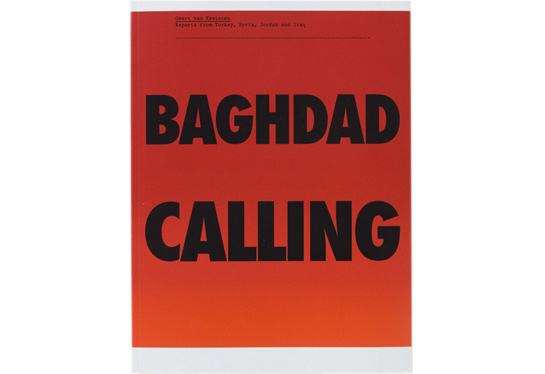Review: Baghdad Calling by Geert van Kesteren

One of the endearing properties of good photobooks is that they don’t get stale. You can pull an older photobook from your shelf, and it will have lost none of its original power. Geert van Kesteren’s Baghdad Calling: Reports from Turkey, Syria, Jordan and Iraq was published two and a half years ago, but I still want to review it here (there exists a microsite for the book). It has not lost its relevance, both in terms of what it deals with and in terms of how it deals with it. (more)
Geert van Kesteren is a Dutch photojournalist, and Baghdad Calling is a piece of photojournalism. It chronicles life in Iraq, seen through the eyes, well camera phone, of Iraqis, and it chronicles the lives of Iraqi refugees outside of Iraq, using Van Kesteren’s photographs.
There has been a lot of talk of “citizen journalism” and of how images by “amateurs” are replacing photographs taken by photojournalists. The book in part supports that latter idea, but it also undermines its simplistic premise in a very smart way. Because large parts of Iraq were a no-go zone for Western journalists when the book was produced, Van Kesteren collected images from the cell phones of Iraqi refugees who, while they still lived in their native country and had an easier time accessing places (the reality, with the then daily abductions and bombs, is much more complex and quite a bit bleaker). But what is crucial here is that it’s not just these images. Van Kestern also collected reports by the people who took these photographs, so that the reader can actually understand what they’re looking at.
Many of the shorter captions underneath these cell-phone images are grim: “I have a lot of pictures of my friends who were killed, bombed or assassinated. These photos show persons who once were my frieds!” reads one, underneath a cell-phone snapshot of two smiling men, one covered in bandages and lying on a bed.
These images provide the bulk of Baghdad Calling. They are printed on newsprint, and the pages feel just like a newspaper, with their ragged edges and the occasional punchmarks that hold blocks of paper together (so you carefully have to pry the pages apart). In between, Van Kesteren (or actually the book’s designers, well-know Dutch designers Mevis & Van Deursen) added his own images and the text plus recollections from some of the refugees on a different paper stock (which also differs in size). This makes for not only a brilliant design decision, it also clearly delineates the photographic spheres. And I feel it is just the right way to elevate the cell phone photographs, while at the same time making it clear that without proper context, without the non-photographic work done by Van Kesteren, this would simply be a collection of cell-phone images, not a story.
Baghdad Calling is a brilliant photobook. But it also serves as an example of how what we call photojournalism in this day and age can work in ways that were unthinkable in the past. This entails including images from “amateurs,” while at the same time paying careful attention to the “journalism” part. Is this part of the future of photojournalism?
Baghdad Calling: Reports from Turkey, Syria, Jordan and Iraq, photography and text collected and/or produced by Geert van Kesteren, additional essays by Jan Gruiters and Brigitte Lardinois, 388 pages, Episode Publishers, 2008